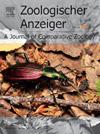To be, or not tu-be? Population structure and connectivity in three Arctic kinorhynch species: Echinoderes aquilonius, Echinoderes eximus and Echinoderes remanei
IF 1.5
3区 生物学
Q2 ZOOLOGY
引用次数: 0
Abstract
The Arctic, despite being profoundly affected by global climate change, remains largely understudied. Its local ecosystems and fauna are undergoing significant changes, including marine meiobenthic invertebrates, such as kinorhynchs. However, although they are an important component of the benthic meiofauna, our understanding of their communities remains relatively limited. The present study focuses on the structure and connectivity of the populations of three Echinoderes species: Echinoderes aquilonius, Echinoderes eximus and Echinoderes remanei, inhabiting the coastal area of Disko Island (Western Greenland). A hypothesis of low population diversity was tested through analyses based on both morphology and the molecular cox1 marker. For the first time the distribution and relationships between and within species were described. Phylogenetic analysis and haplotype networks reflected the results of population statistics (nucleotide and haplotype diversity, Tajima's D and Fu's Fs), revealing expected homogeneity and low diversity, without any noticeable patterns of geographical distribution. The results indicate that Arctic kinorhynchs form progressively developing and expanding communities. Additionally, the analyses revealed a taxonomically important example of intraspecific polymorphism. Presence or absence of tubes are usually considered to be species diagnostic characters, and the finding an isolated population of E. eximus-like specimens with sublateral tubes on segment 9, suggested that this could be a new, yet undescribed species. However, the genetic divergence between these specimens and other populations of E. eximus without tubes on segment 9 was so low that they all have to be considered conspecific. This is the first time molecular sequence data has provided evidence for intraspecific tube polymorphism among kinorhynchs.
要,还是不要?三种北极鞘氨醇物种的种群结构和连通性:Echinoderes aquilonius、Echinoderes eximus 和 Echinoderes remanei:Echinoderes aquilonius、Echinoderes eximus 和 Echinoderes remanei
北极地区尽管受到全球气候变化的深刻影响,但人们对它的研究在很大程度上仍然不足。当地的生态系统和动物群正在发生重大变化,其中包括海洋底栖无脊椎动物,如激游类。然而,尽管它们是底栖小型底栖动物的重要组成部分,我们对其群落的了解仍然相对有限。本研究主要关注三个棘皮动物种群的结构和连通性:Echinoderes aquilonius、Echinoderes eximus 和 Echinoderes remanei。通过基于形态学和分子 cox1 标记的分析,对种群多样性低的假设进行了检验。首次描述了种间和种内的分布和关系。系统发育分析和单倍型网络反映了种群统计(核苷酸和单倍型多样性、Tajima's D 和 Fu's Fs)的结果,揭示了预期的同质性和低多样性,没有任何明显的地理分布模式。研究结果表明,北极鳍鳃亚纲动物形成了逐步发展和扩大的群落。此外,分析还发现了一个在分类学上具有重要意义的种内多态性实例。管的有无通常被认为是种的诊断特征,而发现一个孤立的类似 E. eximus 的标本种群,其第 9 节上有侧下管,表明这可能是一个尚未被描述的新物种。然而,这些标本与其他在第 9 节上没有管的 E. eximus 种群之间的遗传差异非常小,因此必须将它们视为同种。这是分子序列数据首次为奇蹄目中种内管的多态性提供证据。
本文章由计算机程序翻译,如有差异,请以英文原文为准。
求助全文
约1分钟内获得全文
求助全文
来源期刊

Zoologischer Anzeiger
生物-动物学
CiteScore
2.80
自引率
7.10%
发文量
75
审稿时长
>12 weeks
期刊介绍:
Zoologischer Anzeiger - A Journal of Comparative Zoology is devoted to comparative zoology with a special emphasis on morphology, systematics, biogeography, and evolutionary biology targeting all metazoans, both modern and extinct. We also consider taxonomic submissions addressing a broader systematic and/or evolutionary context. The overall aim of the journal is to contribute to our understanding of the organismic world from an evolutionary perspective.
The journal Zoologischer Anzeiger invites suggestions for special issues. Interested parties may contact one of the editors.
 求助内容:
求助内容: 应助结果提醒方式:
应助结果提醒方式:


